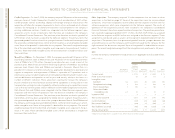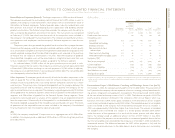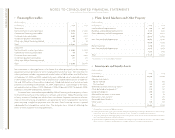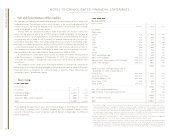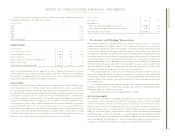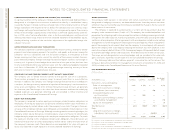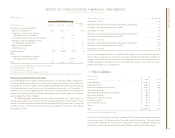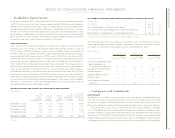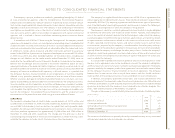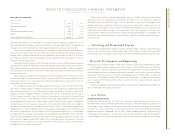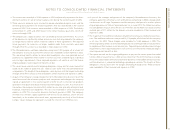IBM 2004 Annual Report Download - page 67
Download and view the complete annual report
Please find page 67 of the 2004 IBM annual report below. You can navigate through the pages in the report by either clicking on the pages listed below, or by using the keyword search tool below to find specific information within the annual report.
NOTES TO CONSOLIDATED FINANCIAL STATEMENTS
65
International Business Machines Corporation and Subsidiary Companies
ibm annual report 2004
Annual contractual maturities on long-term debt outstanding, including capital lease
obligations, at December 31, 2004, are as follows:
(Dollars in millions)
2005 $«3,221
2006 3,104
2007 1,300
2008 499
2009 2,116
2010 and beyond 7,480
interest on debt
(Dollars in millions)
FOR THE YEAR ENDED DECEMBER 31: 2004 2003 2002
Cost of Global Financing $«428 $«503 $«633
Interest expense 139 145 145
Interest expense— discontinued operations ——2
Interest capitalized 415 35
Total interest paid and accrued $«571 $«663 $«815
Refer to the related discussion on page 89 in note x, “Segment Information,” for total
interest expense of the Global Financing segment. See note l, “Derivatives and Hedging
Transactions,” on pages 65 to 67 for a discussion of the use of currency and interest rate
swaps in the company’s debt risk management program.
lines of credit
On May 27, 2004, the company completed the renegotiation of a new $10 billion 5-year
Credit Agreement with JP Morgan Chase Bank, as Administrative Agent, and Citibank,
N.A., as Syndication Agent, replacing credit agreements of $8 billion (5-year) and $2 bil-
lion (364 day). The total expense recorded by the company related to these facilities was
$8.9 million, $7.8 million and $9.1 million for the years ended December 31, 2004, 2003,
and 2002, respectively. The new facility is irrevocable unless the company is in breach of
covenants, including interest coverage ratios, or if it commits an event of default, such as
failing to pay any amount due under this agreement. The company believes that circum-
stances that might give rise to a breach of these covenants or an event of default, as
specified in these agreements, are remote. The company’s other lines of credit, most of
which are uncommitted, totaled $9,041 million and $8,202 million at December 31, 2004
and 2003, respectively. Interest rates and other terms of borrowing under these lines of
credit vary from country to country, depending on local market conditions.
(Dollars in millions)
AT DECEMBER 31: 2004 2003
Unused lines:
From the committed global credit facility $«««9,804 $«««9,907
From other committed and uncommitted lines 6,477 5,976
Total unused lines of credit $«16,281 $«15,883
l. Derivatives and Hedging Transactions
The company operates in approximately 35 functional currencies and is a significant
lender and borrower in the global markets. In the normal course of business, the company
is exposed to the impact of interest rate changes and foreign currency fluctuations, and to
a lesser extent equity price changes and client credit risk. The company limits these risks
by following established risk management policies and procedures including the use of
derivatives and, where cost-effective, financing with debt in the currencies in which assets
are denominated. For interest rate exposures, derivatives are used to align rate movements
between the interest rates associated with the company’s lease and other financial assets
and the interest rates associated with its financing debt. Derivatives are also used to man-
age the related cost of debt. For foreign currency exposures, derivatives are used to limit
the effects of foreign exchange rate fluctuations on financial results.
The company does not use derivatives for trading or speculative purposes, nor is it a
party to leveraged derivatives. Further, the company has a policy of only entering into
contracts with carefully selected major financial institutions based upon their credit ratings
and other factors, and maintains strict dollar and term limits that correspond to the institu-
tion’s credit rating.
In its hedging programs, the company employs the use of forward contracts, futures
contracts, interest rate and currency swaps, options, caps, floors or a combination thereof
depending upon the underlying exposure.
A brief description of the major hedging programs follows.
debt risk management
The company issues debt in the global capital markets, principally to fund its financing
lease and loan portfolio. Access to cost-effective financing can result in interest rate and/or
currency mismatches with the underlying assets. To manage these mismatches and to
reduce overall interest cost, the company primarily uses interest-rate and currency instru-
ments, principally swaps, to convert specific fixed-rate debt issuances into variable-rate
debt (i.e., fair value hedges) and to convert specific variable-rate debt and anticipated
commercial paper issuances to fixed rate (i.e., cash flow hedges). The resulting cost of funds
is lower than that which would have been available if debt with matching characteristics
was issued directly. At December 31, 2004, the weighted-average remaining maturity of
all swaps in the debt risk management program was approximately three years.





